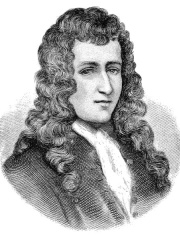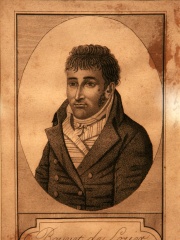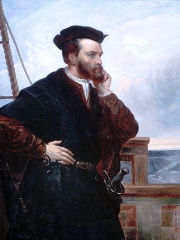
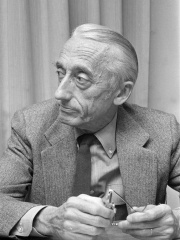
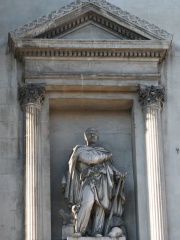
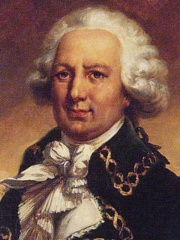
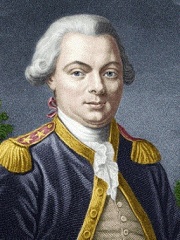
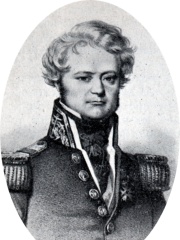
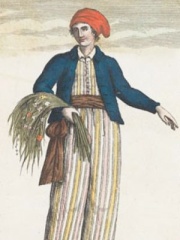
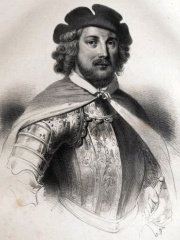
The Most Famous
EXPLORERS from France
This page contains a list of the greatest French Explorers. The pantheon dataset contains 498 Explorers, 37 of which were born in France. This makes France the birth place of the 5th most number of Explorers behind United States, and Portugal.
Top 10
The following people are considered by Pantheon to be the top 10 most legendary French Explorers of all time. This list of famous French Explorers is sorted by HPI (Historical Popularity Index), a metric that aggregates information on a biography's online popularity. Visit the rankings page to view the entire list of French Explorers.

1. Jacques Cartier (1491 - 1557)
With an HPI of 82.21, Jacques Cartier is the most famous French Explorer. His biography has been translated into 147 different languages on wikipedia.
Jacques Cartier (Breton: Jakez Karter; 31 December 1491 – 1 September 1557) was a French maritime explorer from Brittany. Jacques Cartier was the first European to describe and map the Gulf of Saint Lawrence and the shores of the Saint Lawrence River, which he named "The Country of Canadas" after the Iroquoian names for the two big settlements he saw at Stadacona (Quebec City) and at Hochelaga (Montreal Island). Jacques Cartier, author of now-lost maps and accounts of his voyages, was the first European to describe and name this region and its inhabitants—at a time when the Spanish had already settled in the Caribbean, Mexico, and Central America, and were beginning their conquest of Peru.

2. Jacques Cousteau (1910 - 1997)
With an HPI of 78.46, Jacques Cousteau is the 2nd most famous French Explorer. His biography has been translated into 81 different languages.
Jacques-Yves Cousteau, (, also UK: , French: [ʒak iv kusto]; 11 June 1910 – 25 June 1997) was a French naval officer, oceanographer, filmmaker and author. He co-invented the first successful open-circuit self-contained underwater breathing apparatus (SCUBA), called the Aqua-Lung, which assisted him in producing some of the first underwater documentaries. Cousteau wrote many books describing his undersea explorations. In his first book, The Silent World: A Story of Undersea Discovery and Adventure, Cousteau surmised the existence of the echolocation abilities of porpoises. The book was adapted into an underwater documentary called The Silent World. Co-directed by Cousteau and Louis Malle, it was one of the first films to use underwater cinematography to document the ocean depths in color. The film won the 1956 Palme d'Or at the Cannes Film Festival and remained the only documentary to do so until 2004 (when Fahrenheit 9/11 received the award). It was also awarded the Academy Award for Best Documentary in 1957. From 1966 to 1976, he hosted The Undersea World of Jacques Cousteau, a documentary television series. A second documentary series, The Cousteau Odyssey, ran from 1977 to 1982 on public television stations.

3. Pytheas (380 BC - 310 BC)
With an HPI of 74.06, Pytheas is the 3rd most famous French Explorer. His biography has been translated into 55 different languages.
Pytheas of Massalia (; Ancient Greek: Πυθέας ὁ Μασσαλιώτης Pythéās ho Massaliōtēs; Latin: Pytheas Massiliensis; born c. 350 BC, fl. c. 320–306 BC) was a Greek geographer, explorer and astronomer from the Greek colony of Massalia (modern-day Marseille, France). He made a voyage of exploration to Northern Europe in about 325 BC, but his account of it, known widely in antiquity, has not survived and is now known only through the writings of others. On this voyage, he circumnavigated and visited a considerable part of the British Isles. He was the first known Greek scientific visitor to see and describe the Arctic, polar ice, and the Celtic and Germanic tribes. He is also the first person on record to describe the midnight sun. The theoretical existence of some Northern phenomena that he described, such as a frigid zone, and temperate zones where the nights are very short in summer and the sun does not set at the summer solstice, was already known. Similarly, reports of a country of perpetual snow and darkness (the country of the Hyperboreans) had reached the Mediterranean some centuries before. Pytheas introduced the idea of distant Thule to the geographic imagination, and his account of the tides is the earliest one known that suggests the moon as their cause.

4. Louis Antoine de Bougainville (1729 - 1811)
With an HPI of 72.81, Louis Antoine de Bougainville is the 4th most famous French Explorer. His biography has been translated into 50 different languages.
Louis-Antoine, Comte de Bougainville (French: [buɡɛ̃vil]; 12 November 1729 – 31 August 1811) was a French military officer and explorer. After having served in the Seven Years' War and the American Revolutionary War, Bougainville later gained fame for his expeditions, including a circumnavigation of the globe in a scientific expedition in 1763, the first recorded settlement on the Falkland Islands, and voyages into the Pacific Ocean. Bougainville Island of Papua New Guinea as well as the flowering plant Bougainvillea are named in his honour.
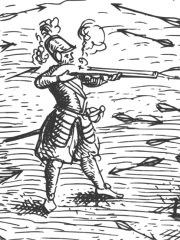
5. Samuel de Champlain (1567 - 1635)
With an HPI of 72.51, Samuel de Champlain is the 5th most famous French Explorer. His biography has been translated into 66 different languages.
Samuel de Champlain (French: [samɥɛl də ʃɑ̃plɛ̃]; baptized 13 August 1574 – 25 December 1635) was a French colonizer, navigator, cartographer, soldier, geographer, diplomat, and chronicler who founded Quebec City and established New France as a permanent French colony in North America. Champlain made between 21 and 29 voyages across the Atlantic Ocean during his career, founding Quebec on 3 July 1608. As an accomplished cartographer, he created the first accurate maps of North America's eastern coastline and the Great Lakes region, combining direct observation with information provided by Indigenous peoples. His detailed maps and written accounts provided Europeans with their first comprehensive understanding of the geography and peoples of northeastern North America. Born into a family of mariners, Champlain began exploring North America in 1603 under the guidance of François Gravé Du Pont. From 1604 to 1607, he participated in establishing Port Royal in Acadia, the first permanent European settlement north of Florida. His subsequent founding of Quebec in 1608 marked the beginning of sustained French colonization in the St. Lawrence River valley. Champlain forged crucial alliances with local Innu (Montagnais), Algonquin, and Wendat (Huron) peoples, relationships that proved essential to the survival and growth of New France. He participated in their conflicts against the Iroquois confederacy and spent extended periods living among Indigenous communities, making detailed ethnographic observations that formed the basis of his published works. In 1620, King Louis XIII ordered Champlain to cease exploration and focus on colonial administration. Although he never held the formal title of governor due to his non-noble status, Champlain effectively governed New France until his death in Quebec on 25 December 1635. His legacy includes numerous geographical features named in his honor, most notably Lake Champlain, and recognition as the "Father of New France."

6. Jean-François de Galaup, comte de Lapérouse (1741 - 1788)
With an HPI of 70.43, Jean-François de Galaup, comte de Lapérouse is the 6th most famous French Explorer. His biography has been translated into 44 different languages.
Chef d'escadre Jean François de Galaup, comte de Lapérouse (French: [lapeʁuz]; 23 August 1741 – c. 1788) was a French Navy officer and explorer. Having enlisted in the Navy at the age of 15, he had a successful career and in 1785 was appointed to lead a scientific expedition around the world. His ships stopped in Chile, Hawaii, Alaska, California, Macau, the Philippines, Korea, Russia, Japan, Samoa, Tonga, and Australia before wrecking on the reefs of Vanikoro in the Solomon Islands.

7. Jules Dumont d'Urville (1790 - 1842)
With an HPI of 69.91, Jules Dumont d'Urville is the 7th most famous French Explorer. His biography has been translated into 47 different languages.
Jules Sébastien César Dumont d'Urville (French pronunciation: [ʒyl dymɔ̃ dyʁvil]; 23 May 1790 – 8 May 1842) was a French explorer and naval officer who explored the south and western Pacific, Australia, New Zealand and Antarctica. As a botanist and cartographer, he gave his name to several seaweeds, plants and shrubs and to places such as d'Urville Island in New Zealand.

8. Jeanne Baret (1740 - 1807)
With an HPI of 68.70, Jeanne Baret is the 8th most famous French Explorer. Her biography has been translated into 39 different languages.
Jeanne Baret ([ʒan baʁɛ]; 27 July 1740 – 5 August 1807) was a French explorer, naturalist, and botanist who is recognised as the first woman to have completed a voyage of circumnavigation of the globe, which she did via maritime transport. A key part of her journey was as a member of Louis Antoine de Bougainville's expedition on the ships Boudeuse and Étoile in 1766–1769. Jeanne Baret joined the expedition disguised as a man, calling herself Jean Baret. She enlisted as valet and assistant to the expedition's naturalist, Philibert Commerson, shortly before Bougainville's ships sailed from France. According to Bougainville's account, Baret was an expert botanist.

9. Jean de Béthencourt (1362 - 1425)
With an HPI of 68.25, Jean de Béthencourt is the 9th most famous French Explorer. His biography has been translated into 25 different languages.
Jean de Béthencourt (French pronunciation: [ʒɑ̃ də betɑ̃kuːʁ]; 1362–1425) was a French explorer who in 1402 led an expedition to the Canary Islands, landing first on the north side of Lanzarote. From there he conquered for Castile the islands of Fuerteventura (1405) and El Hierro, ousting their local chieftains (majos and bimbaches, ancient peoples). Béthencourt received the title Lord of the Canary Islands ("Señor"), named himself King of the Canary Islands, but recognized King Henry III of Castile, who had provided aid during the conquest, as his overlord.
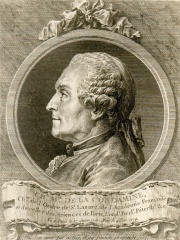
10. Charles Marie de La Condamine (1701 - 1774)
With an HPI of 67.91, Charles Marie de La Condamine is the 10th most famous French Explorer. His biography has been translated into 32 different languages.
Charles Marie de La Condamine (French: [la kɔ̃damin]; 28 January 1701 – 4 February 1774) was a French explorer, geographer, and mathematician. He spent ten years in territory which is now Ecuador, measuring the length of a degree of latitude at the equator and preparing the first map of the Amazon region based on astro-geodetic observations. Furthermore he was a contributor to the Encyclopédie.
People
Pantheon has 37 people classified as French explorers born between 380 BC and 1910. Of these 37, none of them are still alive today. The most famous deceased French explorers include Jacques Cartier, Jacques Cousteau, and Pytheas.
Deceased French Explorers
Go to all RankingsJacques Cartier
1491 - 1557
HPI: 82.21
Jacques Cousteau
1910 - 1997
HPI: 78.46
Pytheas
380 BC - 310 BC
HPI: 74.06
Louis Antoine de Bougainville
1729 - 1811
HPI: 72.81
Samuel de Champlain
1567 - 1635
HPI: 72.51
Jean-François de Galaup, comte de Lapérouse
1741 - 1788
HPI: 70.43
Jules Dumont d'Urville
1790 - 1842
HPI: 69.91
Jeanne Baret
1740 - 1807
HPI: 68.70
Jean de Béthencourt
1362 - 1425
HPI: 68.25
Charles Marie de La Condamine
1701 - 1774
HPI: 67.91
René-Robert Cavelier, Sieur de La Salle
1643 - 1687
HPI: 66.88
Jean-Baptiste Charles Bouvet de Lozier
1705 - 1786
HPI: 66.26
Overlapping Lives
Which Explorers were alive at the same time? This visualization shows the lifespans of the 25 most globally memorable Explorers since 1700.

